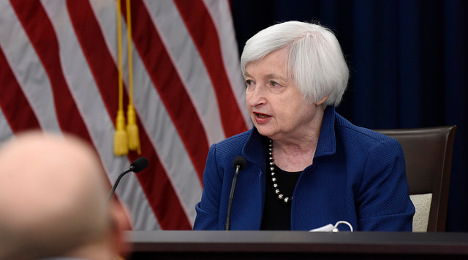Where interest rates could be by end of 2019

Federal Reserve chair Janet Yellen explains why the federal funds rate rose by 0.25 percent during a press conference on Wednesday. (Photo courtesy of the Federal Reserve)
By subscribing, you agree to receive communications from Auto Remarketing and our partners in accordance with our Privacy Policy. We may share your information with select partners and sponsors who may contact you about their products and services. You may unsubscribe at any time.
CARY, N.C. –
With the federal funds rate ticking up by 0.25 percent to 1 percent as widely expected on Wednesday, Federal Reserve chair Janet Yellen also described the expected median path for the federal funds rate through the close of 2019, which she insisted was “essentially unchanged,” from projections made in December.
Yellen predicted the federal funds rate upward path has it rising to 1.4 percent at the end of this year, 2.1 percent by the close of next year and 3 percent at the end of 2019. During her prepared remarks, she reiterated why the Federal Open Market Committee (FOMC) took action on Wednesday.
“The committee judged that a modest increase in the federal funds rate is appropriate in light of the economy’s solid progress toward our goals of maximum employment and price stability. Even after this increase, monetary policy remains accommodative, thus supporting some further strengthening in the job market and a sustained return to 2 percent inflation,” she said.
“Today’s decision also reflects our view that waiting too long to scale back some accommodation could potentially require us to raise rates rapidly sometime down the road, which, in turn, could risk disrupting financial markets and pushing the economy into recession,” Yellen continued. “We continue to expect that the ongoing strength of the economy will warrant gradual increases in the federal funds rate to achieve and maintain our objectives. That’s based on our view that the neutral nominal federal funds rate — that is, the interest rate that is neither expansionary nor contractionary and keeps the economy operating on an even keel — is currently quite low by historical standards. That means that the federal funds rate does not have to rise all that much to get to a neutral policy stance.
“We also expect the neutral level of the federal funds rate to rise somewhat over time, meaning that additional gradual rate hikes are likely to be appropriate over the next few years to sustain the economic expansion. Even so, the committee continues to anticipate that the longer-run neutral level of the federal funds rate is still likely to remain below levels that prevailed in previous decades,” she went on to say.
Comerica Bank chief economist Robert Dye described the tenor coming from the Federal Reserve as “just slightly more hawkish” than its previous announcement. Dye elaborated about what he meant in a commentary distributed following Yellen’s appearance on Wednesday.
Subscribe to Auto Remarketing to stay informed and stay ahead.
By subscribing, you agree to receive communications from Auto Remarketing and our partners in accordance with our Privacy Policy. We may share your information with select partners and sponsors who may contact you about their products and services. You may unsubscribe at any time.
“It is fair to say that the Yellen Fed remains somewhat tactical in their policy changes. By staying with their projections of three rate hikes this year and next, the Fed is maintaining flexibility around the exact timing of rate hikes,” Dye said.
“However, at the same time, the Fed has now added weight to the precedent of one rate hike every other meeting,” he continued. “As of this writing, the implied odds of the next rate hike coming at the conclusion of the upcoming FOMC meeting on May 3 are quite low at 4.3 percent, according to the fed funds futures market. The odds of the next rate hike coming on June 14 jump to 48.5 percent.
“With June near even money, that leaves the timing of the third rate hike this year in question, adding to financial market uncertainty,” Dye went on to say. “So it looks like the Fed still has some work to do in setting market expectations for the second half of this year. Fed officials are likely waiting as long as possible for some clarity on fiscal policy before they cross that bridge. Nonetheless, they will need to clarify forward guidance soon.”
Stifel Nicolaus chief economist Lindsey Piegza took a similar view when she examined the Fed’s actions and projections, also touching on what took her a bit by surprise.
“The unexpected was the language in the FOMC statement and documents accompanying the rate decision and whether or not it would provide additional guidelines for the future of monetary policy in the remaining nine months of the year,” Piegza said. “The statement, however, was somewhat disappointing, offering few hints as to the number or timing of future rate hikes.
“Acknowledging the improvement in the underlying economy, the Fed remained cautious in overemphasizing such improvement, particularly on the inflation side,” she continued. “After all, committee members are all too aware that the recent increase in prices stems in good part from a reversal in energy costs temporarily buoying the year-over-year calculation.
“However, as energy prices stabilize in the spring or summer, the upward momentum is expected to wane, eventually putting downward pressure on topline inflation measures,” Piegza added.


